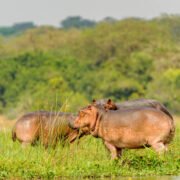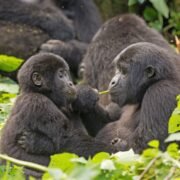
The Remarkable Recovery Story of Akagera National Park
AKAGERA’S ASTONISHING REBIRTH
Nestled along Rwanda’s eastern frontier, where the land rolls gently into the Tanzanian plains, lies a wilderness once thought lost Akagera National Park. Today, it stands as one of Africa’s most inspiring conservation success stories, a tale of revival, resilience and rebirth that has transformed a war scarred landscape into a thriving safari destination.
Not long ago, Akagera National Park was a shadow of its former self. A wilderness unravelled by conflict, emptied by poachers and dangerously close to losing everything, it stood as a painful reminder of how fast nature can fall when left unprotected. Today, that same landscape tells a very different story. It stands as one of Africa’s greatest conservation triumphs.
This is not just a story of recovery. It is a story of resurrection.
FROM NEAR DESTRUCTION TO A SYMBOL OF HOPE
In the aftermath of the 1994 genocide, Akagera’s future looked bleak. The park, once teeming with wildlife, became a refuge for returning communities seeking safety and farmland. Boundaries blurred, trees were felled, and poaching ran rampant. By the early 2000s, lions had been hunted to extinction in the park, elephants had been reduced to a handful, and much of the once lush savannah was silent.
It would have been easy to let Akagera fade into history, another casualty of human tragedy. But Rwanda had other plans. Determined to restore its natural heritage, the Rwanda Development Board (RDB) formed a groundbreaking partnership in 2010 with African Parks, a non-profit conservation organisation renowned for reviving protected areas across the continent.
That collaboration marked the dawn of a new era.
The Turning Point: Rebuilding Akagera
The first task was ambitious reclaim the park and restore the rule of law. A professional management team was established, a dedicated ranger force was trained, and a high-tech operations room equipped with GPS tracking and drones began monitoring every corner of the park. Poaching, once rampant, plummeted almost overnight.
Next came the heart of the mission bringing the wildlife back home.
THE RETURN OF THE KINGS: LIONS AND RHINOS COME BACK
In 2015, a historic moment unfolded: seven lions were reintroduced to Akagera from South Africa, marking the first time in 15 years that the park heard their powerful roars. Within months, they began breeding, a sound symbolising not just the return of the king but the rebirth of an ecosystem.
Then, in 2017, came the black rhinos, a species that had vanished from Akagera for nearly a decade. The journey of 18 rhinos from South Africa to Rwanda was one of the largest translocations in conservation history and a powerful statement of faith in the park’s future.
And just when the story couldn’t get more thrilling, in 2021, white rhinos were introduced from &Beyond Phinda Reserve, making Akagera the only park in East Africa where you can find both species living side by side a conservation triumph few places in the world can boast.
A Haven of Biodiversity
Today, Akagera’s landscape, a stunning mosaic of lakes, wetlands and rolling grasslands, is alive once more. Over 13,000 large mammals roam its plains, including elephants, buffaloes, leopards, giraffes, zebras and an ever-growing population of lions and rhinos.
Bird enthusiasts find paradise here too, with over 490 bird species, including the rare shoebill stork and the majestic African fish eagle. The park’s intricate network of lakes, especially Lake Ihema, provides a tranquil haven for hippos and crocodiles, the perfect backdrop for a boat safari that feels straight out of a wildlife documentary.
A Rising Star of African Safari Tourism
Today, Akagera National Park is not only a conservation success, it’s also a rising star in Rwanda’s tourism portfolio. Tourists can embark on classic game drives, glide silently across the mirror like waters of Lake Ihema or stay in eco luxury lodges that blend seamlessly with the wild.
Each sunrise over the misty plains carries a powerful message: that nature, when given a chance, can heal.
The Future is Bright
Akagera’s comeback is far from over. Plans are underway to expand its conservation impact, strengthen anti-poaching technologies, and ensure that both wildlife and communities continue to thrive together. It stands today as a beacon of what’s possible when vision, dedication and local involvement come together for a common goal.
A Testament to Rwanda’s Spirit
In many ways, Akagera’s story mirrors that of Rwanda itself, a nation that rose from tragedy to become one of Africa’s cleanest, safest and most forward looking countries. Both tell a story of resilience, unity and unwavering belief in the power of renewal.
Akagera isn’t just a destination, it’s an inspiration. It’s a living, breathing reminder that conservation isn’t just about protecting wildlife, it’s about restoring hope, identity and pride.
So, the next time you hear the distant roar of a lion echoing across the Rwandan savannah, remember that sound isn’t just nature’s call it’s the triumphant heartbeat of a nation that chose to rise again.



